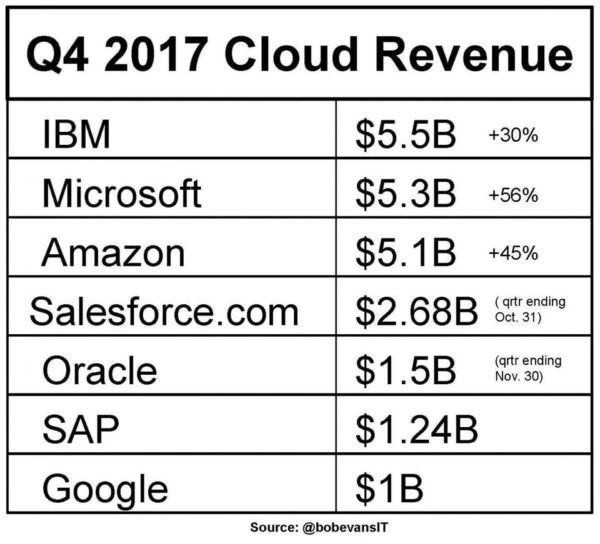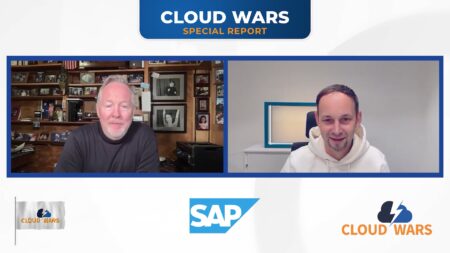Hammering home the radical transformation IBM’s undergone during the last few years ago, CEO Ginni Rometty claimed last week that IBM has become the world leader in enterprise AI with 16,000 client engagements, in Blockchain with 400 active client engagements, and in the highly advanced realm of quantum computing with live projects underway with JPMorganChase, Daimler and others.

Those striking numbers underscore not only IBM’s aggressive moves into enterprise IT’s highest-potential markets, but also the legitimacy of the company’s claims that it has earned its way into the very top of the wickedly competitive cloud-computing marketplace with Microsoft and Amazon.
If that seems like a silly claim, take another look at the graphic atop this article—and if you’re still not convinced, have a look at this chart showing that IBM generated more enterprise-cloud revenue in Q4 than both Microsoft and Amazon.

Rometty also made it clear that while IBM has a considerable presence in the public-cloud IaaS market because many of its clients require or desire that, it intends to greatly differentiate itself from the big IaaS providers via higher-value technologies such as AI, Blockchain, cybersecurity and analytics.
“I think you know that for us the cloud has never been about having Infrastructure-as-a-Service-only as a public cloud, or a low-volume commodity cloud,” Rometty said on the webcast with investors.
“Because, frankly, Infrastructure as a Service is almost just a dialtone. For us, it’s always been about a cloud that is going to be enterprise-strong and of which IaaS is only a component.”
Rometty then framed out four strategic differentiators for the IBM Cloud, which in 2017 generatedd $17 billion in revenue, accounting for 22% of IBM’s total:
- “The IBM Cloud is built for “data and applications anywhere,” she said. “When we say you can do data and apps anywhere, it means you have a public cloud, you have private clouds, you have on-prem environments, and then you have the ability to connect not just those but also to other clouds. That is what we have done—all of those components.”
- The IBM Cloud is “infused with AI,” Rometty said, alluding to how most of the 16,000 AI engagements also involve the cloud. And she cited four of the most-popular ways in which customers are using AI: customer service, enhancing white-collar work, risk and compliance, and HR.
- For securing the cloud for IBM clients, the company has more than 50 cybersecurity centers around the world to ensure “the IBM Cloud is secure to the core,” Rometty said.
- “Fourth—and perhaps this the most important differentiator—you have to be able to extend your cloud into everything that’s going to come down the road, and that could well be more cyber analytics but it is definitely Blockchain, and it is definitely quantum because that’s where a lot of new value is going to reside.”
Rometty then described some of those Blockchain and quantum client engagements.
“In food safety, it started with WalMart, and now we’re at Dole, Unilever, Kroger, Tyson, and a very long list. Some are friends, and some are competitors—it’s a proof to this point of all-around food safety” being an ideal opportunity for Blockchain’s trusted-transaction capabilities.
In financial services, IBM’s using Blockchain in currency-derivatives applications with Goldman Sachs, Bank of America, Bank of Tokyo-Mitsubishi and others, Romettys aid.
And in the $4-trillion market for global shipping, Rometty said IBM decided to enter into a joint venture with world-leader Maersk, with that initiative having attracted more than 30 companies participating in either beta tests or being actively onboarded.
In quantum, IBM’s leveraging its first-mover status and has moved far beyond theoretical proposals, Rometty said.
“We are the only company with a 50-qubit system that is actually working—we’re not publishing pictures of photos of what it might look like, or writings that say if there is quantum, we can do it—rather, we are scaling rapidly and we are the only one working with clients in development working on our quantum,” Rometty said.
For example:
- JPMorgan Chase is working on risk optimization and portfolio optimization using IBM quantum computing;
- Daimler is using IBM’s quantum technology to explore new approaches to logistics and self-driving car routes; and
- JSR—”and there are many like this”—is doing computational chemistry to create entirely new materials.
Rometty also went into some detail describing the significant overhaul of the IBM global workforce. Of the company’s 360,000 employees, 50% have been with the company for only 5 years or less, she said.
And much of that new talent is directly focused on IBM’s new businesses and opportunities, she said, emphasizing the effort that IBM has put into ensuring that it transforms not only what type of work is being done, but also how it is being done:
- 1,500 IBM people are working on Blockchain;
- 15,000 designers have been added across the company to infuse design thinking into every appropriate process and function;
- 8,000 people are now working in the company’s $3-billion cybersecurity business; and
- 7,000 IBM employees are working in healthcare, primarily with the Watson AI applications across different fields of medicine and healthcare.
“IBM’s a very different company than it was 10 years ago, or 5 or even 3,” Rometty said, “albeit we know there are still some spaces where we’ve got more work to do—and have no fear, we have not lost track of that.”
*******************
RECOMMENDED READING FROM CLOUD WARS:
The World’s Top 5 Cloud-Computing Suppliers: #1 Microsoft, #2 Amazon, #3 Salesforce, #4 SAP, #5 IBM
Amazon Versus Oracle: The Battle for Cloud Database Leadership
As Amazon Battles with Retailers, Microsoft Leads Them into the Cloud
Why Microsoft Is #1 in the Cloud: 10 Key Insights
SAP’s Stunning Transformation: Qualtrics Already “Crown Jewel of Company”
Watch Out, Microsoft and Amazon: Google Cloud CEO Thomas Kurian Plans To Be #1
The Coming Hybrid Wave: Where Do Microsoft, IBM and Amazon Stand? (Part 1 of 2)
Oracle, SAP and Workday Driving Red-Hot Cloud ERP Growth Into 2019
*********************
Subscribe to the Cloud Wars Newsletter for twice-monthly in-depth analysis of the major cloud vendors from the perspective of business customers. It’s free, it’s exclusive, and it’s great!








